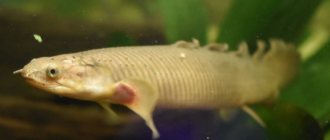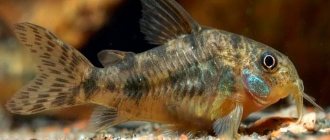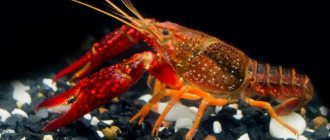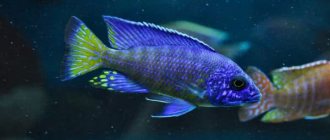04/07/2019Pisces0
Unpretentious and adaptable to various conditions, Afiosemions are quite popular among aquarists. In their natural environment, these fish choose to live in secluded thickets of coastal plants, small puddles and places with little current or with stagnant, soft water rich in organic matter.
- 1 Description and natural habitat
- 2 Mr. Tail Recommends: Varieties
- 3 Basics of aquarium keeping
- 4 Compatibility
- 5 Feeding
- 6 Breeding
- 7 Diseases and prevention
Description and natural habitat
In these representatives of the carp-toothed family, males and females are very different from each other. Male individuals have bright colors and variegated fins. The length of their slender body can reach 7 cm. Gray female specimens look inconspicuous, simple and dull against the background of males. They grow up to 5 cm. The body is cylindrical and slightly resembles a miniature pike, the forehead is flattened, the mouth is upper, the eyes are large, the caudal fin is lyre-shaped. Coloring varies depending on the specific environmental conditions. Afiosemion Gardner has a fantastic contrasting color.
Photo gallery of Afiosemionov:
The fish live in a school, headed by a colorful and large male. Males are naturally aggressive towards each other, but in a large aquarium they behave calmly, since their attention is dispersed in the presence of many fish. The lifespan of Afiosemion Gardner, Striatum and many other species of this family is about 2-2.5 years.
The natural habitat of these fish is drying up reservoirs of savannas or tropical forests of Central and Western Africa. The ray-finned species, A. striatum, is found in streams and small rivers. The Southern, Striped Afiosemion lives in the swamps. They belong to the Killi Fish group, which unites representatives of different families that live in small shallow reservoirs (streams, creeks).
This is a predator that can hunt during daylight hours. Adults prefer to do this alone in the middle and upper layers of water. The menu often includes small fish, shrimp, cyclops, daphnia, insect larvae, and mollusks.
Compatibility with other fish
The ideal solution for keeping killifish would be biotope or species aquariums. There is always a strict hierarchy in a flock of Afiosemions. As a result, “fights” for leadership occur from time to time. As a rule, within a species they are of an indicative nature and rarely result in injury. But neighbors with luxurious, veiled fins will be bitten by aggressive males.
For proximity in a common aquarium, you can consider species of similar size. They get along with catfish, tetras and rasboras. Large predators will consider Afiosemion as food.
Mr. Tail recommends: varieties
The wide variety of Afiosemions allows every connoisseur of exotics to find a suitable specimen for their aquarium. A description of the most common members of the family is given in the table.
| View | Description |
| Gardneri/Fundulopanchax (Gardner's) | The length of the body is 6-7 cm. The color of the scales is green-blue, the edging of the fins is yellow. The color contains bright red specks. Females are spotless, brownish-silver in color. |
| Australe (Southern) | The brightest representative of his family. Males have red or orange-brown scales with bright speckles, while females have light brown scales with a few faded spots. The fish grows up to 6-7 cm. |
| Bitaeniatum (Double-striped) | Color varies from green to yellow, and from red to purple. The upper part of the body is always darker than the lower part. The massive dorsal fin is orange. The length of the fish is 5 cm. |
| Coeleste (Blue) | They have an aggressive character. The gentle blue color of the individual is complemented by bright red splashes. At home they grow up to 12 cm. Females are smaller than males. |
| Striatum (Striatum) | The contrasting color of the fish is emphasized by lined red spots. So that the color of the scales of males is turquoise-blue, and that of females is golden and brown. |
| Margaretae (Margaret) | These representatives of the species have a brown upper body and a white or light lower body. The spots are scattered randomly over the body. Females are gray with transparent fins. Individuals grow up to 4.5 cm. |
| Sjoestedti Lonnenberg (Blue Pheasant) | Males have reddish-brown bodies with bluish-green sides and red, white dots. The body up to 12 cm long is decorated with vertical stripes. |
| Amieti (Amieta) | Like Gardner's Afiosemion, Amieta lives in wetlands. The body is green on top and yellow (sometimes gold) below. A reddish line of many small red dots runs along the body. The individual grows up to 7 cm. |
General appearance features
There are a large number of varieties of aphiosemion, each of which has its own specific characteristics. But they all have common features:
- Body . It is elongated and streamlined, resembling a large drop of water in shape.
- The tail is of an original shape, resembling a trident.
- The head is quite large, with a dense forehead and large, expressive eyes.
- The fins are quite powerful, large and voluminous, which allows them to move freely and quickly in the water. The dorsal fin occupies almost the majority of the rear surface of the body. The pectorals are thin and translucent, and in water they appear completely colorless.
- The color depended on the variety. In any case, all species are characterized by bright and original coloring. Males have more saturated colors compared to females. According to experts, the degree of brightness of the color of Afiosemion largely depends on the place of residence, diet and conditions of detention.
Aquarium Basics
To recreate living conditions, a sandy dark substrate is placed on the bottom and soft, slightly acidic or neutral water is poured. Fluid changes are performed 10-20% once every 2 weeks when the tank volume is 100 liters or more; if less, the frequency is reduced.
Water requirements:
- temperature - +21…+32 °C;
- acidity - 5.5-7.0;
- hardness - 5-10 dH.
To shade and create shelter, driftwood, intertwined roots, branches, and dense thickets of plants, including floating ones, are used.
Gardner's Afiosemion (Fundulopanchax gardneri)
The small 6-7 cm fish has become famous among aquarists thanks to its unusual deep green-blue scales, on which bright red specks are randomly scattered throughout the body. It often happens that the spots seem to spread and merge, forming bizarre patterns and lines on the body.
The edges of all fins, except the lateral ones, are bordered by bright yellow lines. The pupils are black with a gold frame. Females are more modest in their attire. They are less bright and their body has a brownish-silver tint. There are no spots or they are pale and almost invisible.
They are not demanding in their maintenance, they are not interested in plants and do not nibble them, they do not dig up the soil, and they are peaceful and friendly towards their neighbors.
Thanks to this calm nature, you can keep animals alone or in a flock, but in this case you need to be prepared for rivalry and occasional fights between males. The recommended ratio of different-sex fish is 2-3 females per male.
The volume of the aquarium is selected in a ratio of 6:1 (6 liters per fish). Comfortable water temperature is 22-24°C.
They eat with the same appetite both dry special food and live food (bloodworms, tubifex), so feeding will also not be difficult.
Life expectancy is 2-2.5 years.
Gardner's aphioseminon.
Breeding
A couple of breeders are placed in a 20 liter container of water, the parameters of which are similar to the liquid in an aquarium. A week before this, the individuals are kept separately and well fed. Fish can lay eggs 1 mm in size in the amount of 300 pieces in the ground (incubation period - 5-7 weeks) and on plant leaves (ripening lasts 2 weeks). The larvae are born 5 mm in size. Development occurs quickly, and sexual maturity occurs after 2-3 months.
Oviparous carp fish can be bred according to one of the following scenarios:
- The pair are kept in the aquarium until the fry appear on the surface of the water. The young are caught and transferred to another container.
- The pair is left in place, and the substrate with the eggs is moved into a vessel filled with 3-5 cm of water. Within 4-5 days, the fungus-affected and whitened unfertilized eggs are removed.
- The pair is removed, and the liquid level in the aquarium is reduced to 3-5 cm. To help hatching, you can shake the container or pour cool water over the embryos.
When breeding in an aquarium, the incubation period for Afiosemion lasts 14-21 days.
Habitat
Originates from the territory of Nigeria and Cameroon (Africa), found in the Niger and Benue river systems, as well as in coastal reservoirs where rivers and streams flow into the sea.
Natural habitats range from tropical rainforests to dry savannahs, where rivers often dry up completely. Brief information:
- Aquarium volume - from 60 liters.
- Temperature - 20–26°C
- pH value – 6.0–7.5
- Water hardness - soft (1–10 dGH)
- Substrate type - any
- Lighting - any
- Brackish water - no
- Water movement is weak
- The size of the fish is 5–6 cm.
- Food - any combination feed
- Temperament - peaceful
- Group maintenance in the ratio of one male and 3–4 females
Classification
There are 95 known species of Afiosemion:
- Aphyosemion abacinum
- Aphyosemion ahli - Afiosemion Alya, or caliurum Alya
- Aphyosemion alpha
- Aphyosemion amoenum
- Aphyosemion aureum
- Aphyosemion australe - Southern aphyosemion
- Aphyosemion bamilekorum - Aphyosemion Radda
- Aphyosemion batesii
- Aphyosemion bitaeniatum
- Aphyosemion bivittatum
- Aphyosemion bualanum
- Aphyosemion buytaerti
- Aphyosemion callipteron
- Aphyosemion calliurum
- Aphyosemion cameronense
- Aphyosemion campomaanense
- Aphyosemion castaneum
- Aphyosemion caudofasciatum
- Aphyosemion celiae
- Aphyosemion chauchei
- Aphyosemion christyi
- Aphyosemion citrineipinnis
- Aphyosemion coeleste
- Aphyosemion cognatum
- Aphyosemion congicum
- Aphyosemion cyanostictum
- Aphyosemion dargei
- Aphyosemion decorsei
- Aphyosemion ecucuense
- Aphyosemion edeanum
- Aphyosemion elberti
- Aphyosemion elegans
- Aphyosemion erythron
- Aphyosemion escherichi
- Aphyosemion etsamense
- Aphyosemion exigoideum
- Aphyosemion exiguum
- Aphyosemion ferranti
- Aphyosemion franzwerneri
- Aphyosemion fulgens
- Aphyosemion gabunense
- Aphyosemion georgiae
- Aphyosemion hanneloreae
- Aphyosemion heinemanni
- Aphyosemion hera
- Aphyosemion herzogi
- Aphyosemion hofmanni
- Aphyosemion joergenscheeli
- Aphyosemion kouamense
- Aphyosemion koungueense
- Aphyosemion labarrei
- Aphyosemion lamberti
- Aphyosemion lefiniense
- Aphyosemion lividum
- Aphyosemion loennbergii
- Aphyosemion louessense
- Aphyosemion lugens
- Aphyosemion lujae
- Aphyosemion maculatum
- Aphyosemion malumbresi
- Aphyosemion melanogaster
- Aphyosemion melinoeides
- Aphyosemion mimbon
- Aphyosemion musafirii
- Aphyosemion ocellatum
- Aphyosemion ogoense
- Aphyosemion omega
- Aphyosemion pascheni
- Aphyosemion passaroi
- Aphyosemion plagitaenium
- Aphyosemion poliaki
- Aphyosemion polli
- Aphyosemion primigenium
- Aphyosemion punctatum
- Aphyosemion punctulatum
- Aphyosemion raddai
- Aphyosemion rectogoense
- Aphyosemion riggenbachi
- Aphyosemion schioetzi
- Aphyosemion schluppi
- Aphyosemion seegersi
- Aphyosemion splendopleure
- Aphyosemion striatum
- Aphyosemion teugelsi
- Aphyosemion thysi
- Aphyosemion tirbaki
- Aphyosemion trilineatus
- Aphyosemion volcanum
- Aphyosemion wachtersi
- Aphyosemion wildekampi
- Aphyosemion wuendschi
- Aphyosemion zygaima
General information
Afyosemion sp. is a genus of freshwater fish from the order Cyprinodontiformes, living in West Africa. They are found mainly in small, often dry bodies of water with a gentle current.
The natural habitat conditions of the fish are truly extreme. Significant temperature changes (up to 20°C), changes in water acidity and hardness, and in some cases even complete drying out of water bodies are found everywhere in the area where fish live. Thus, the entire life cycle is inextricably linked with the rainy and dry seasons, for which the fish are called seasonal. This rhythm has led to the fact that killifish reach sexual maturity very quickly, or the eggs are able to remain in wet peat for a long time before the onset of the rainy season.
The hierarchical connections in flocks of aphiosemions are very interesting. The main, most energetic male has an advantage in nutrition and reproduction. It stays near the spawning substrate and fertilizes nearby females. Other males can challenge his authority only through battle. But if fortune does not smile on the attacker and he loses, then his color will turn pale, and the fish itself will not feed for several days and will hide in a far, dark corner. But after a few days, the loser returns to the pack, and the cycle repeats.
From the editor: All about aquarium goldfish
The taxonomy of aphiosemions is quite complex and confusing. There are many interspecific hybrids on sale, as well as a number of commercial names, which complicates identification. But nevertheless, even the most sophisticated aquarist will be able to find an afiosemion in accordance with his tastes.











